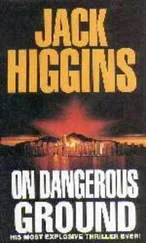Seeing Patterson’s expression, Davis answered truthfully, “I am curious, too, sir.”
“Curiosity is not a good enough reason for risking a multimillion-dollar ROV and the covertness of this mission. Imagine the Russians’ surprise if they discovered a ROV entangled in the cargo hold of a barge inside their territorial waters.”
“Oh, and do you think they come here and check often?” Patterson’s tone was acidic.
Davis raised a hand. “Captain, Doctor, we’re using up Huey’s batteries while we argue. Why don’t I maneuver over the open hatch, point the camera down, and see what we can see?”
Hardy couldn’t argue with that — and didn’t. Patterson just smiled broadly. Jerry had to force himself to watch the Manta’s display, stealing only occasional glances at the ROV’s video screen.
Emily approached the barge slowly, careful to use a path as clear of obstructions as possible. With a delicate touch, she lowered the ROV to deck level, with the camera and light overhanging the open hatch. She panned the lens back and forth.
The inside of the hold revealed only dark, angular shadows. It was an unsatisfying image and Patterson clearly wanted more. “Shift the ROV a little,” she ordered. “Maybe if the light comes in at a different angle. ”
“Yes,” Davis answered softly. Skillfully, she backed Huey away and then approached again, so that the light came in from another direction, almost ninety degrees off the earlier view. It was no more revealing, although combining the two views suggested rectangular boxes or crates — a lot of them.
“We have to send the ROV in,” Patterson insisted.
“What’s the radiation reading?” Hardy temporized.
“Very slight, only 10 millirem per hour,” Davis reported. “The cargo is radioactive, but what it is I can’t imagine. It certainly doesn’t look like spent fuel.”
“Those are not spent fuel containers,” Patterson declared. “At least they’re no shape I’ve ever seen or read of.” She looked at Hardy and put her hand on his arm. “Please, Captain.”
Almost startled by her polite intensity, Hardy nodded silently to Davis, who settled herself and took a deep breath.
“First. I’m going to inspect the edge of the hatchway. I want to make sure that there are no sharp edges or hidden snags.” She panned the camera over all four sides of the opening at maximum magnification. The edges were smooth and regular and were covered with a layer of fine silt. “I’m going to reposition,” she announced and backed the ROV off.
The new path brought Huey in at a forty-five-degree angle, so that its length lay across the corners of the hatch, not its edges. She came up to the opening, paused, then scanned the camera in all directions before moving forward. After a few yards, she paused and looked again. It took two more pauses before Davis was satisfied with the Huey’s position in the hatchway.
She gently lowered the ROV, angling the thruster to move it vertically. While everyone was curious about the cargo, Emily kept the cameras pointed at the edge of the hatch so she could gauge Huey’s movements.
She let Huey settle until the ROV was well clear of the hatchway, at least four feet overhead. The camera’s view was being obscured by silt, but not too badly. “I’m killing the motors,” she suddenly announced. “There won’t be a current here.” Hopefully the neutrally buoyant ROV would hover, motionless, as the sediment settled.
When she pointed the camera down, the image was reasonably clear. They could see the cargo hold, perhaps thirty or forty feet long, running across the width of the barge. It was filled by rectangular boxes, about half the length of the ROV. They had obviously been stacked in two layers in the hold, but had been jostled around somewhat by the sinking.
Risking a short puff of the thruster, Davis pivoted Huey in place, but the rest of the hold simply held more boxes.
“I’m going to approach one,” she announced and lightly touched the controls. The ROV drifted forward, and within a few moments, she was just two yards away from the stacked objects.
“That is not a waste container,” Patterson repeated. “Look at it. It’s a case or a crate. See the latches and the lid? That isn’t how you seal a container of radioactive waste.”
“It is if you’re a Soviet bureaucrat,” answered Hardy. “Especially one who doesn’t give a fig about the consequences. I agree it wasn’t built to hold waste, but that’s doesn’t tell us what’s inside there now.”
“Except that it’s radioactive, but not all that much.” Emily added, looking at the meter.
“How about unspent fuel rods?” Hardy suggested.
Patterson shrugged. “That’s a funny way to store them, and it’s a lot of them to store. See if you can find any markings.”
Emily slowly maneuvered Huey in the hold, bringing the camera to bear on the tops and sides of several boxes. While they may have had markings, they had been sloppily but thoroughly sprayed over with black paint. Only a Cyrillic R, in black, was visible on one of the box ends.
Watching the battery level, Davis finally announced. “I’m bringing Huey out. We need to come home.”
“Wait!” ordered Patterson. “Can we take a sample in here?”
“Of what?” asked Hardy.
“At least get a water sample,” Patterson insisted and Emily complied. First, she stirred up the silt with Huey’s thruster, so that some of the sediment would be included in the sample.
Even as the sample was being collected, Davis carefully positioned the ROV, then ascended through the hatch. This time, with experience and the open water ahead of her, she maneuvered it more surely. She still had to be careful of the thin fiber-optic cable, making sure it did not loop around an obstruction or snag on a jagged surface.
“Take another sample here, right next to the hull,” Patterson directed, although as Davis positioned Huey and started the sequence, Jerry thought she looked unsatisfied.
Davis had barely started the ROV toward Memphis when Patterson said, “Captain, I need to open one of those cases. We have to see what’s inside them.”
Astounded, Hardy firmly replied. “Out of the question, Doctor. We’ve talked about this before. I won’t bring anything radioactive that doesn’t fit in the sample tubes aboard Memphis. And just how did you intend to examine it?”
“With the divers. And they wouldn’t have to bring it aboard if they opened it there, in the hold.”
That suggestion froze Jerry’s blood solid. Send them into there, to open one of those cases?
Hardy was gentler with her idea than Jerry would have expected. “Dr. Patterson, you don’t know what you’re asking.”
“It’s shallow enough. And they wouldn’t have to do anything complicated. Just swim in and open a case.”
“Exposing them to whatever’s inside,” Hardy added. “What if it’s toxic or highly radioactive? We don’t know what those cases are made of, so we certainly can’t estimate their shielding qualities. You know that even a small amount of material would constitute a dangerous dose to anyone in close proximity. I won’t risk anyone just to satisfy your curiosity.”
“But this is what we’ve been looking for! We can’t go back with the site unidentified.”
“Doctor, even if I were to agree with you, the barge is miles inside Russian waters. I’d have to bring Memphis in close just so that they could make the swim, and I’m not allowed to enter Russian territory. They’d be unhappy enough about ROVs and the samples if they knew.”
“But we’ve hardly seen any Russian ships or planes. Can’t you just look at the chart?” she wheedled. “If we can get close enough, it’s just a short swim…”
Читать дальше












